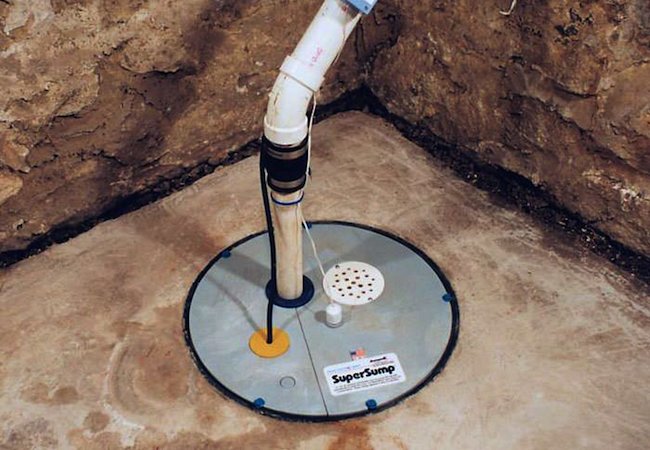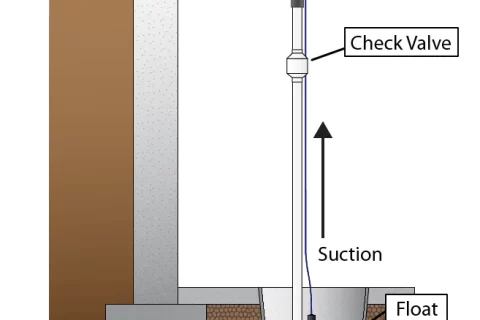Sump pumps are essential parts of residential plumbing systems. They remove water from basements and crawl spaces through pipes and drains. Sump pumps also prevent flooding during heavy rainstorms or other extreme weather conditions.
If you live in a basement apartment, you probably don’t want to see the ugly black pipe running down into your living room. The problem is, these pipes are visible even though they’re hidden under the floorboards.
You can easily disguise them using some common household items. In this article we will show you how to hide sump pump discharge pipe without drilling or cutting holes in walls.

The Best Ways To Hide Sump Pump Discharge Pipe
Sump pumps are not just for removing water from the foundation; they also serve as an alarm system that alerts homeowners when there is too much water in their house. When the overflow gets high enough, the pump kicks on and begins pumping water out of the home.
While it may be tempting to drill holes in your walls and floors to allow water to drain away, doing so could result in damaging plasterboard walls and concrete slab surfaces.
Instead, use DIY solutions to hide sump pump drainage pipes while keeping them intact and protected. You do not need any special tools or skills to perform these simple fixes.
Here are different ways to cover up or blend in sump pump discharge pipe:
Use landscaping to hide the drain pipe.
If your sump pump is outside, shrubs or trees in the landscape may be able to hide it. You might also think about using attractive mulch or boulders to hide the discharge pipe. Make sure that you position the landscaping just right so that it doesn’t affect drainage.
Subterranean installation of the discharge pipe.
Under concrete, which won’t be visible all year round, you can hide the pipe. It is advised to bury the pipe to prevent blockages from leaves and other debris. If you have an area with low-lying soil, then you should consider installing a drain tile instead of underground piping. This option is more expensive than burying the pipe and requires extra maintenance.
Attach a storm sewer to the discharge pipe.
In order to use this option, you must dig up a portion of your grass and attach the discharge pipe to a neighboring storm drain. Storm drains are open conduits designed for draining surface runoff into streams, lakes, etc. They’re located on public property (such as roads) and require permission to connect. However, if you own the land where the sump pump is installed, you may install the discharge pipe there without having to ask anyone’s permission.
Place a screen over the discharge pipe.
The tank can be enclosed, and a mesh screen can be placed over the exit line. The discharge pipe won’t be harmed by leaves or other debris thanks to the screen. But you’ll need to take care not to get any of the material inside the pipe.
Create a tiny stone or wooden structure to conceal the discharge pipe.
The discharge pipe can be housed in a straightforward wooden box. You might also build a stone wall to surround the pipe. This method shouldn’t cause any problems for your garden as long as the pipe doesn’t stick out above the ground.
Paint your home’s exterior to match the discharge pipe.
To make the discharge pipe blend in with the rest of the house, paint it black. The pipe will be more resistant to corrosion with black paint.
Join the septic tank’s discharge pipe.
Connect the discharge pipe directly to the effluent line of your septic system in place of a sump pump. In this instance, the effluent line would transport waste outside of the house as opposed to burying it. Plus, when the effluent line has been connected to a tank, you won’t have to worry about clogs in the pipes caused by tree roots or leaves.
Cover the drain pipe.
A plumbing disaster could result if a pipe bursts inside a larger container when the complete piping system is contained because it is difficult to tell where one pipe starts and another finishes. Manually block off each area of discharged water to avoid this issue. Hold the pieces together with electrical wire or duct tape until you have a chance to replace them.
Create a covert sump pit.
It is feasible to construct a small pit below the surrounding ground’s grade level. To avoid the pit overfilling, make sure it contains a drainage hole. To isolate the pit’s base from the surrounding earth, use cement or stone blocks.
Sump pump discharge pipe can be hidden in many ways. If you need help finding an alternative solution to hide sump pump discharge pipe, you can post your question here. We hope that these DIY methods were helpful to you! Do you find anything else interesting? Let us know what you think in the comments below.



